Saltwater pools are becoming more and more popular and it’s easy to see why. It’s extremely environmentally friendly and low maintenance, needing much less chemical application than other chlorine pools.
However, for the saltwater chlorinator (aka salt chlorine generator) to work properly, it needs a minimum water temperature range.
The lowest temperatures a saltwater chlorine generator operates at is on average 50°F (10°C) to 60°F (15°C). Below these temperatures, saltwater cells are less effective. Many chlorine generator products such those made by Jandy, Astral, Hayward and Pentair, will shut down completely when temperatures are below these limits.
Depending on the brand of saltwater chlorinator you have may give you a bit of flexibility in what the lowest temperature it can efficiently work at.
In this article, we’ll be looking at saltwater generators from Jandy, Astral, Zodiac, Aqua Rite, Hayward, Goldline, CircuPool, Ace, Pentair so read on to get the most out of your chlorinator.
Article Contents
What’s the Lowest and Ideal Temperature for My Generator?
Below is a table of the most popular saltwater generators. Each one has the optimal temperature to keep your SWG at and the lowest temperature it can work.
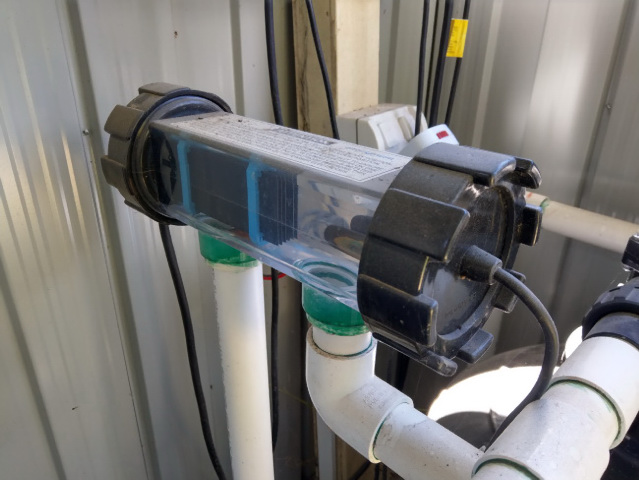
Summary of Lowest Temperatures Saltwater Generators Work At
| Brand | Ideal Temperature | Reduced Efficiency Temperature |
| Ace | 100-104 °F (38-40 C) | <100°F (38 °C) |
| Aqua Rite | > 50°F (10°C) | <50°F (10 °C) |
| Astral | > 60°F (15°C) | < 60°F (15°C) |
| CircuPool | > 60°F (15°C) | < 60°F (15°C) |
| Goldline | > 60°F (15°C) | < 60°F (15°C) |
| Hayward | > 60°F (15°C) | < 60°F (15°C) |
| Jandy | >51°F (10°C) | >51°F (10°C) |
| Pentair | >52 F (11°C) | <52°F (11°C) |
| Zodiac | 50 – 104°F (10-40°C) | < 60°F (15°C) |
As you can see, there are a lot of temperature similarities between the saltwater generators of different brands. Some of those mentioned generators work best in hot tubs which require the saltwater chlorinator to function at a higher temperature than the others.
Most chlorine generators have a warning light when the water temperature is low. Check out our article here which explains what all the warning lights mean and what to do:
Why Are My Saltwater Chlorine Generator Warning Lights On (solved!)
And here’s the full list of the minimum temperature a chlorinator (aka saltwater chlorine generator) will work at.
Lowest Temps Saltwater Generators Work (Full List)
| Brand | Model | Lowest temperature | Source (User Manual) |
| Hayward | W3AQR15 | No chlorine produced < 50ºF. | Hayward W3AQR15 User Manual |
| Hayward | W3AQ-TROL-RJ | No chlorine produced < 50ºF. | Hayward W3AQ-TROL-RJ User Manual |
| Hayward | W3AQ-TROL-RJ-TL | No chlorine produced < 50ºF. | Hayward W3AQ-TROL-RJ-TL User Manual |
| Hayward | W3AQR9 | No chlorine produced < 50ºF. | Hayward W3AQR9 User Manual |
| Hayward | W3AQ-TROL-HP | No chlorine produced < 50ºF. | Hayward W3AQ-TROL-HP User Manual |
| Hayward | W3SWP9 | No chlorine produced < 50ºF. | Hayward W3SWP9 User Manual |
| Hayward | W3AQR3 | No chlorine produced < 50ºF. | Hayward W3AQR3 User Manual |
| Jacuzzi | JSCS40 | Unknown | |
| Jacuzzi | J-SS40 | If water temperature exceeds 113º F, the Cell may fail. | Jacuzzi J-SS40 User Manual |
| AutoPilot | ChlorSync CS30 | 1% Output at < 55°F (13°C) | AutoPilot ChlorSync CS30 User Manual |
| AutoPilot | ChlorSync CS40 | 1% Output at < 55°F (13°C) | AutoPilot ChlorSync CS40 User Manual |
| AutoPilot | ChlorSync CS50 | 1% Output at < 55°F (13°C) | AutoPilot ChlorSync CS50 User Manual |
| AutoPilot | Digital Nano+ with PPM2 (RC-28) | 1% Output at < 55°F (13°C) | AutoPilot Digital Nano+ with PPM2 (RC-28) User Manual |
| AutoPilot | Digital PPM1 (RC-35) | 1% Output at < 55°F (13°C) | AutoPilot Digital PPM1 (RC-35) User Manual |
| AutoPilot | Digital PPM3 (RC-42) | 1% Output at < 55°F (13°C) | AutoPilot Digital PPM3 (RC-42) User Manual |
| AutoPilot | Digital PPM4 (RC-52) | 1% Output at < 55°F (13°C) | AutoPilot Digital PPM4 (RC-52) User Manual |
| AutoPilot | Digital PPM5 (CC-15) | 1% Output at < 55°F (13°C) | AutoPilot Digital PPM5 (CC-15) User Manual |
| CFICGEN40 | |||
| CircuPool | CORE-15 | 50% output at 64°F 25% output at 59°F | CircuPool CORE-15 User Manual |
| CircuPool | CORE-35 | 50% output at 64°F 25% output at 59°F | CircuPool CORE-35 User Manual |
| CircuPool | CORE-55 | 50% output at 64°F 25% output at 59°F | CircuPool CORE-55 User Manual |
| CircuPool | EDGE-15 | Reduced chlorine output at low temps. | CircuPool EDGE-15 User Manual |
| CircuPool | EDGE-25 | Reduced chlorine output at low temps. | CircuPool EDGE-25 User Manual |
| CircuPool | EDGE-40 | Reduced chlorine output at low temps. | CircuPool EDGE-40 User Manual |
| CircuPool | RJ-20 | No chlorine produced < 65ºF. | CircuPool RJ-20 User Manual |
| CircuPool | RJ-30 | No chlorine produced < 65ºF. | CircuPool RJ-30 User Manual |
| CircuPool | RJ-45 | No chlorine produced < 65ºF. | CircuPool RJ-45 User Manual |
| CircuPool | RJ-60 | No chlorine produced < 65ºF. | CircuPool RJ-60 User Manual |
| CircuPool | SJ-20 | Reduces chlorine output in cold water. No chlorine produced < 65ºF. | CircuPool SJ-20 User Manual |
| CircuPool | SJ-35 | Reduces chlorine output in cold water. No chlorine produced < 65ºF. “Service” LED will come on. | CircuPool SJ-35 User Manual |
| CircuPool | SJ-45 | Reduces chlorine output in cold water. No chlorine produced < 65ºF. “Service” LED will come on. | CircuPool SJ-45 User Manual |
| CircuPool | Universal25 | Reduces chlorine output in cold water. No chlorine produced < 65ºF. “Service” LED will come on. | CircuPool Universal25 User Manual |
| CircuPool | Universal40 | Reduces chlorine output in cold water. No chlorine produced < 65ºF. “Service” LED will come on. | CircuPool Universal40 User Manual |
| CircuPool | Universal55 | Reduces chlorine output in cold water. No chlorine produced < 65ºF. “Service” LED will come on. | CircuPool Universal55 User Manual |
| ControlOMatic | ChlorMaker-DRP | Unknown | ControlOMatic ChlorMaker-DRP User Manual |
| ControlOMatic | MegaChlor | Unknown | ControlOMatic MegaChlor User Manual |
| ControlOMatic | SmarterSpa | Unknown | ControlOMatic SmarterSpa User Manual |
| Jandy | AquaPure 1400 | No chlorine produced < 51°F (11°C). | JandyAquaPure 1400 User Manual |
| Jandy | TruClear | Turn off below 55°F (13°C). | JandyTruClear User Manual |
| Pentair | Intellichlor (EC-520556 and EC-520554) | No chlorine produced < 52°F (11°C) | Pentair Intellichlor (EC-520556 and EC-520554) User Manual |
| Pentair | Intellichlor (EC-520556 and EC-520555) | No chlorine produced < 52°F (11°C) | Pentair Intellichlor (EC-520556 and EC-520555) User Manual |
| Pentair | Intellichlor (EC-520556 and EC-521105) | No chlorine produced < 52°F (11°C) | Pentair Intellichlor (EC-520556 and EC-521105) User Manual |
| Pentair | iChlor 15 (523080) | No chlorine produced < 52°F (11°C) | Pentair iChlor 15 (523080) User Manual |
| Pentair | iChlor 30 (523081) | No chlorine produced < 52°F (11°C) | Pentair iChlor 30 (523081) User Manual |
| Pentair | iChlor 20 | No chlorine produced < 52°F (11°C) | Pentair iChlor 20 User Manual |
| Saline Generating Systems (CMP Powerclean Ultra) | Breeze 320 | Reduced chlorine production < 60°F | Saline Generating Systems (CMP Powerclean Ultra)Breeze 320 User Manual |
| Saline Generating Systems (CMP Powerclean Ultra) | Breeze 540 | Reduced chlorine production < 60°F | Saline Generating Systems (CMP Powerclean Ultra)Breeze 540 User Manual |
| Saline Generating Systems (CMP Powerclean Ultra) | Breeze 760 | Reduced chlorine production < 60°F | Saline Generating Systems (CMP Powerclean Ultra)Breeze 760 User Manual |
| CaliMar | CMARSSG20-5Y | Reduced or no chlorine production < 60°F Status light flashes & service light on. | CaliMarCMARSSG20-5Y User Manual |
| CaliMar | CMARSHA15-3Y | Reduced or no chlorine production < 60°F Status light flashes & service light on. | CaliMarCMARSHA15-3Y User Manual |
| Solaxx | CLG225A | Unknown | Solaxx CLG225A User Manual |
| Solaxx | SALT340A | Unknown | Solaxx SALT340A User Manual |
| INTEX | Krystal Clear | Unknown | INTEX Krystal Clear User Manual |
| BLUE WORKS | BLH30 | No chlorine produced < 65°F | BLUE WORKSBLH30 User Manual |
| Intermatic | I-Pure | Unknown | Intermatic I-Pure User Manual |
Ideal Saltwater Generator Temperatures
The design behind a saltwater generator is simple, user-friendly, and good for the environment. Saltwater chlorinated pools keep the water sanitized with just the added salt.
How it works is by using a chlorinator cell (an electrode) that breaks down the salt into sodium and chloride ions into the pool. This ‘free’ chlorine is perfect for keeping the pool clean. And any excess chlorine will bind back to the free sodium (i.e. salt) which will flow back into the generator to continue the sanitizing process.
However, to successfully convert the saltwater and generate chlorine, it needs the right temperature to work at. This temperature is above 60°F (or 16°C). So, if the pool temperature falls below this, the SWG will completely shut down. It’s by design to cut off below a certain temperature to stop the salt cell from breaking down (ionizing).
Related Reading: 5 Options for Swimming Pool Digital Thermometers
Why Do Salt Water Generators Stop Working in the Cold?
Saltwater generators are designed to reduce their chlorine production, or completely shut off, if the pool water temperature gets too cold. Most manufacturers have roughly the same cut-off temperature. But you can find out what temperature yours shuts off below.
The reason SWGs shut off below 60°F (or 16°C) is that the chlorinator cell needs to work harder to produce chlorine in colder water. This is because as the temperature of the water lowers, so does the conductivity of salt water. Most ions need a certain level of heat to separate and then rebind.
The longer the saltwater chlorinator works harder than normal, the shorter the lifespan the cell has. So keeping your pool warm, especially during winter, is ideal for prolonging the life of your SWG.
However, you might not want to keep your pool heated during the colder season. So you can help the generator keep the pool sanitized by adding chlorine yourself. If you choose to do this, it’s important to regularly test the chemical composition of your pool.
It’s worth noting that most algae and bacteria activity will reduce during colder temperatures so a reduced chlorine output isn’t a worry.
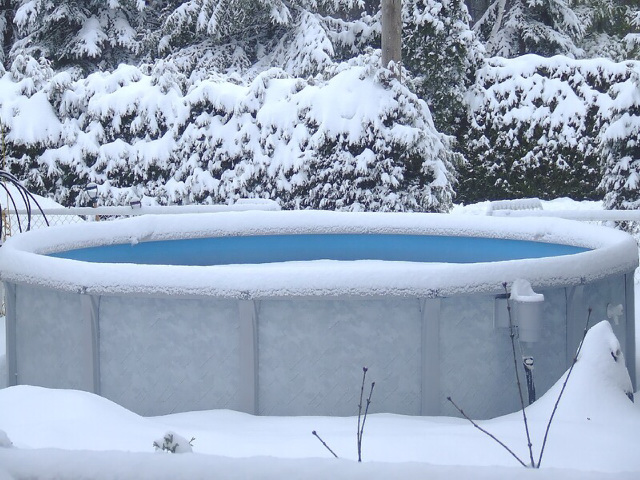
What to Do if Water Temperature is Too Low
There are a few steps you can take if the water temperature is too low for your saltwater generator to work. For more people, this will only be an issue in Winter or Early Spring/Late Fall (Autumn). You can use a pool heater, cover the pool to retain the heat, use Winter Mode capable SWGs, add regular chlorine or close your pool.
Add Chlorine
Did you know you can add chlorine to a saltwater pool? Many people have misconceptions when it comes to saltwater pools. The biggest misconception is that the pool kills bacteria with saltwater. In reality, the saltwater chlorine generator generates chlorine by converting the saltwater to chlorine.
If the water temperature is too low for your salt cell to work, you can do what chlorine pool owners do, add chlorine. You can do this with either liquid chlorine, chlorine tablets or granular chlorine. Just make sure you maintain the chlorine levels between 3 and 5 ppm.
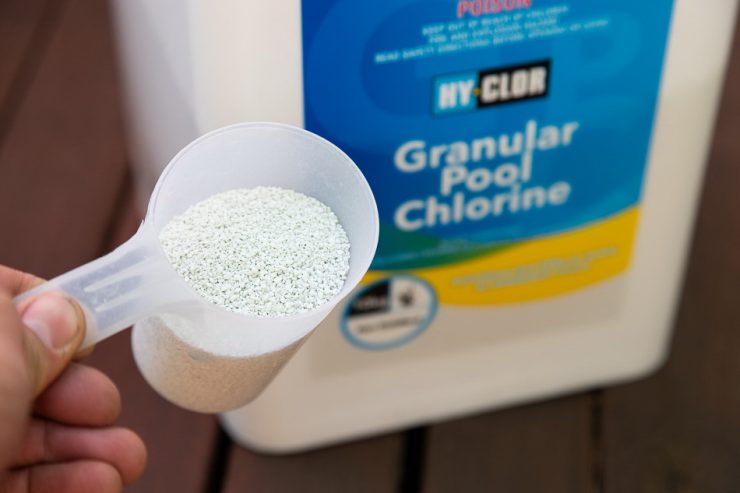
Pool Heater
Using a pool heater will remove the worry of manually maintaining the pool temperature high enough for the saltwater chlorine generator to work. However, they are expensive to run – especially as the climate gets cooler and cooler.
For people that live in an area with cold winters, it will unlikely be practical to run a pool heater through winter.
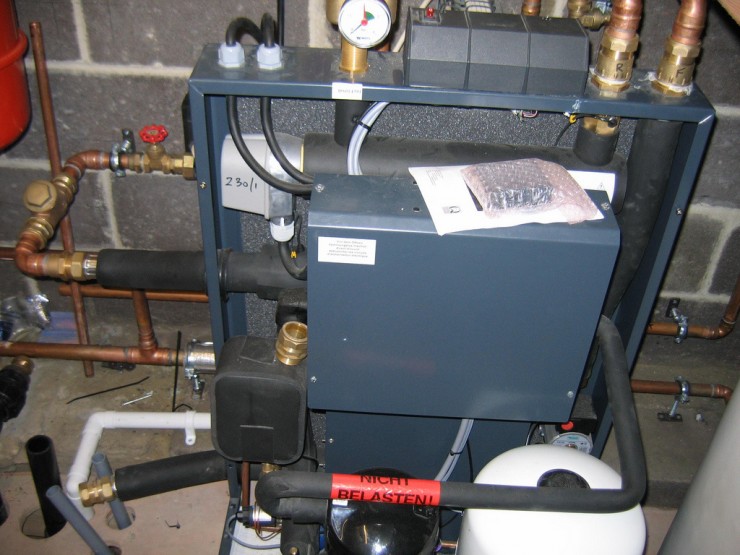
Pool Cover
If you live in a mild winter climate, a simple pool cover might do the trick. Some pool covers can actually warm the water. Why not check out this article to see if a pool cover is a solution for you?
Winter Mode
Some saltwater generators have a Winter mode built into them. This mode allows you to program the generator to work in colder conditions. However, most models in Winter mode will reduce chlorine production by 20%. You’ll need to add additional chlorine to maintain your pool.
Though, if you’re prepared for this adjustment it won’t negatively affect your pool.
Close Your Pool
Perhaps you have no intention of using your pool during the cold season and want to completely shut it down. Closing a saltwater pool down for the winter is a little different than regularly chlorinated pools.
Before you follow the recommended steps of winterizing your pool, you’ll need to disconnect the chlorinator. (Unsure what’s involved in closing your pool for the winter? Click here to learn more).
The first thing you need to do is disconnect the SWG from the mains. Then you’ll need to remove the chlorinator cell and clean it with an electrolytic cell cleaner. And then store it in a dry place safe from harsh weather conditions.
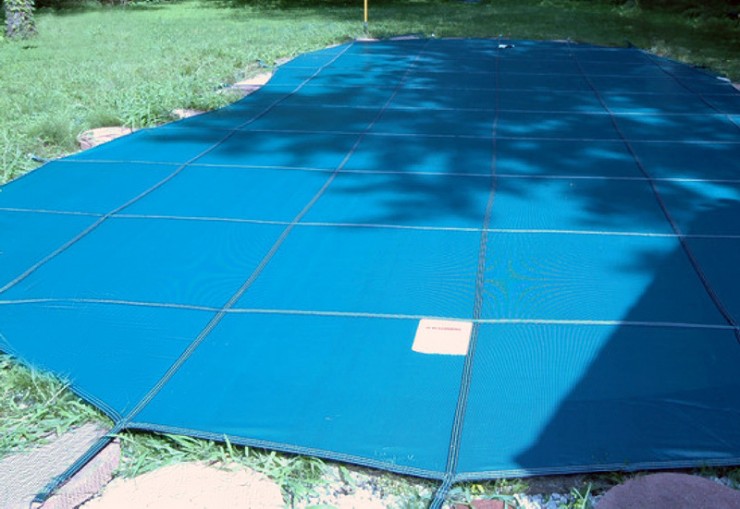
Final Thoughts
Understanding the temperature ranges these SWGs need is important to maintain a sanitized pool throughout the colder months. Hopefully, this guide has helped calm any concerns about how to keep your saltwater working properly during the winter season.

